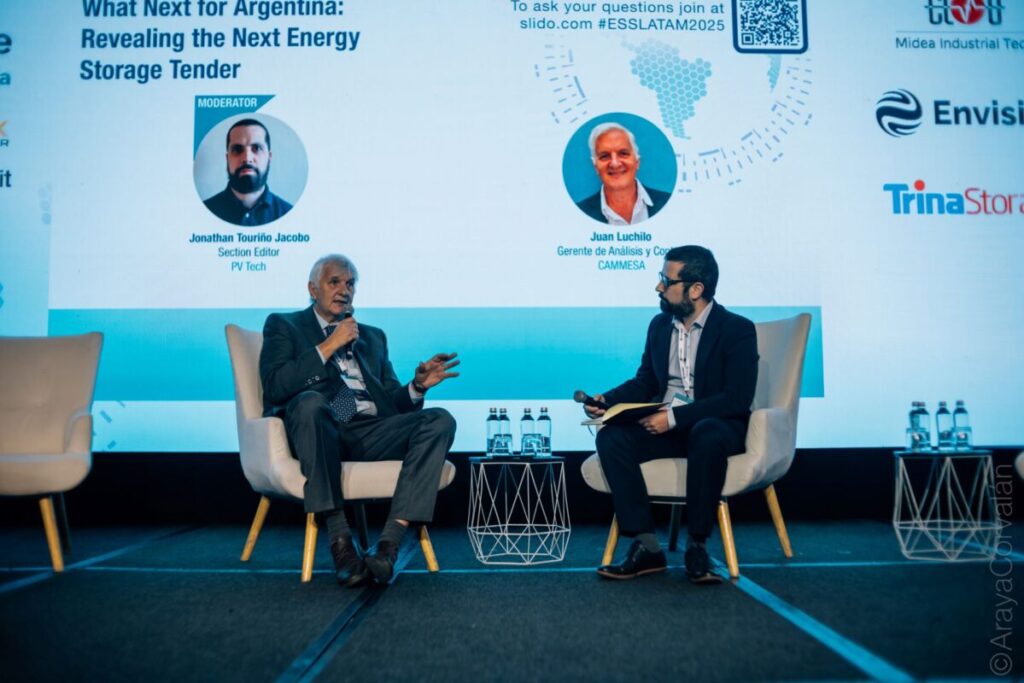
When energy storage enters a new market or region, its role can vary as the technology can be applied for different necessities.
In the case of Argentina and its recent standalone tender, this solution was very clear: what the country was seeking with the tender was for energy storage to function as peak shaving, explained Juan Luchilo, analysis and control manager at wholesale market operator CAMMESA (Compañía Administradora del Mercado Mayorista Eléctrico Sociedad Anónima).
Luchilo spoke in a fireside chat with Energy-storage.news during the fourth edition of Energy Storage Latin America in Santiago, Chile, earlier this month about Argentina’s recent AlmaGBA tender, which saw nearly 700MW of battery energy storage systems (BESS) awarded for an initial tendered capacity of 500MW.
He also touched on the prospects of a future tender for storage in 2026, and how CAMMESA is looking at different options for it.
Try Premium for just $1
- Full premium access for the first month at only $1
- Converts to an annual rate after 30 days unless cancelled
- Cancel anytime during the trial period
Premium Benefits
- Expert industry analysis and interviews
- Digital access to PV Tech Power journal
- Exclusive event discounts
Or get the full Premium subscription right away
Or continue reading this article for free
Varied demand through year creates need for flexibility
Luchilo explains that Argentina’s electricity demand can vary greatly throughout the year, both during the summer and in winter time. During the summer, the country can reach highs of 31GW of energy demand during the hotter days whereas more normal summer days can reach up to 21GW.
This means that the country requires up to 10GW of thermal conditioning for only a few days in the year. Considering that a great part of the electricity demand is concentrated in Buenos Aires – which was the focus of the AlmaGBA tender – this requires the use of resources with low usage rates.
That role was historically reserved for hydropower and thermal plants. “Equipment that’s used for perhaps 100 or 200 hours a year. This is a significant capital investment for very low utilisation rates.”
“Storage fits perfectly with our requirements. Our peak power lasts four hours. Therefore, in a power storage system with that capacity, it’s sufficient to perform the peak shaving required by the Argentine system.”
Payment based on the power and variable services
When asked about the offtake and financing of the first tender, Luchilo said that Cammesa acted as the final guarantor and operational administrator of the contracts between the generators and distributors – which are Edenor and Edesur.
He added that the payment was based on two main points, with the most important one based on the payment for the power, based on the base of the offered price. This was set at US$15,000/MW/month. However, the tender ended up averaging a price of nearly US$11,700/MW/month, representing 78% of the maximum offered.
“The prices we’ve had were very competitive. We were most likely very lucky,” he said.
Most of the projects awarded in AlmaGBA were to Argentinian companies. However, Luchilo highlighted the interest in attracting international players in the future, similar to what María Tettamanti, Argentina’s secretary of energy, spoke about during her presentation at the event in Chile.
The second point for the payment was based on variable services, says Luchilo.
“We discussed whether to include something associated with marginal costs or not. But ultimately, it was decided, for the simplicity of the bidding process, to establish a regulated payment for each charge and discharge cycle of US$10/MWh with $20/MWh being the cost of losses associated with charging and discharging,” explains Luchilo, adding that there is a limit of 180 cycles per year and not the usual 360 cycles. This is due to the fact that the Argentinian system doesn’t need 180 cycles per year.
One of the learnings from that first tender was an understanding of the industry’s willingness to invest in these “new technologies” for the Argentinian market. On top of that, Luchilo added the speed at which these new capacities can be added to the grid – with operations expected in the next 12 to 18 months – and its efficiency.
Looking ahead to a future tender expected for next year, with the hopes to launch it during Summer 2026, one of the aspects Luchilo highlights is the idea to open the tender to the entire country, inviting local authorities and provinces to participate in a similar scheme as AlmaGBA in Buenos Aires.
“This has yet to happen, but the door remains open,” explained Luchilo. The details are still being worked out for a future tender, but Luchilo said that it is in the works and different options are being analysed.
“The power level could be in the range of 400MW or 1,000-1,500 MW. It depends greatly on timing and needs. There’s also an intention for autonomous development. At the same time, we don’t want to block it with centralised bidding.”
Regarding the financial part of the tender and how projects would be paid, Luchilo said: “It’s a scheme that would naturally include power payment, energy payment. This could be partial or for a period of time at a regulated price and then deregulated.
“Furthermore we would incorporate the provision of regulating reserve services, primarily primary frequency reserve, into the contract, as well as include the concept of voltage and reactive power control. This would help shape these short-term reserve markets.”
Outside of the structure and requirements for a possible next tender, Luchilo also mentioned how the Argentinian system differs from other markets such as Chile. He explained that Argentina currently doesn’t have a curtailment problem, while in Chile the issue has kept growing in 2025, but at a slower rate. On the other hand, storage could be used as a solution for the restrictions on moving electricity throughout Argentina.
